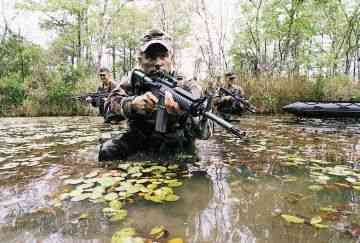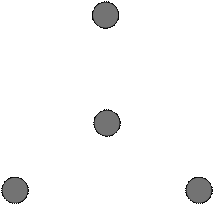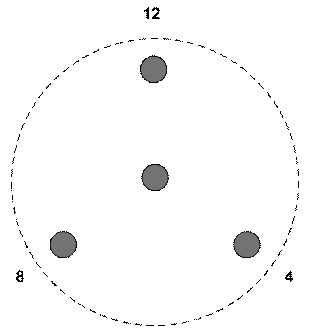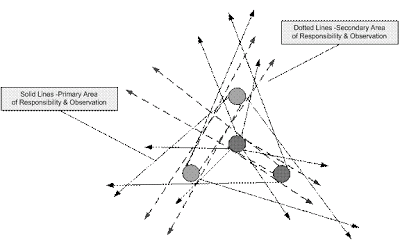
The latest from the Trainer. Much wisdom here.
Mike
III
Secure Patrol/Ops Base
When in the field for training or for “real world”, each established Group or Training Team will be responsible for their own Patrol or Operations Base including set up, positioning, concealment, security, and usability by team members.
For a Patrol Base to be effective, it must meet certain criteria.
Requirements:
360 Degree Security/Observation
Interlocking fields of fire
Mutual Support
Defense in Depth
Flexible (expand or contract as necessary)
Concealable
Easily learned
A well-tested formation that also fits well into any Maneuver Warfare ‘play book’ is the “Reinforced Triangle”. It is ideal for groups of 4 to 12 as a single, self-sustaining “base camp”, and should the situation warrant, can be expanded into a series of RT’s that will provide an almost impenetrable perimeter as it grows and positions are improved into prepared, defensive positions.

Figure 1 – Basic Reinforced Triangle
As diagramed, the strengths of the RT become apparent:
Each position has the ability to mutually support all others by fire if required.
No one position is left without a fall back position (the center).
360 degree observation is achieved (perimeter interlock & mutual support).
Distance between positions is flexible (terrain & situation dependent)
Any position can be developed to hold/house 2 or more team members (each point of the triangle could be developed as a triangle in and of itself).

Figure 2 – RT Perimeter Interlock and Mutual Support
Establishment:
Moving In – The RT, like most other temporary perimeters, is established by “moving in” from a tactical movement formation by a fire team or larger strength group. For academic purposes, we’ll keep it at fire team level and, again for academic purposes, we’ll presume we are moving at night, so we’ll use the file as our formation to move into and set up the RT. Note: That does not mean the only formation to use is the file; it just best suits night movement most of the time. In terrain that’s open or sparsely covered, other formations would be better suited; in tight cover or extreme darkness, the file is best suited.

Each position within the file has its own primary Area of Responsibility to watch over. The secondary area of responsibility for each position is directly opposite of the positions primary area.
To move in, the FT Leader stops the movement and signals to his team what he wants done:
When each team member moves into his or their (larger teams) respective positions
TL takes the center of the RT
TL check the positions; establish as appropriate tug lines, fall backs, emergency egress rally points, etc.
If and when to start improving the position (as warranted for the length of the stop – generally a 12 or more hour establishment would justify the establishment of at least hasty fighting positions).
o Hygiene Considerations: All ‘cat hole’ areas should be downwind, down hill (if possible), 30 meters away from the RT, concealed, and not placed near any potable water source.
The team leader places the ‘points’ at the following clock positions by visual signals:
Point 1: 12 O’clock
Point 2: 4 O’clock
Point 3: 8 O’clock

Figure 3 – RT Position Establishment
The team leader determines 12 O’clock by his direction of travel or use of a landmark he and other team members can easily recognize, area of primary concern, or assigned area of responsibility. It should be noted that the 12 O’clock position is not necessarily the “front”; it is simply a baseline used for ease of RT establishment. The RT has no “front”, per se, and many times two of the 3 points will be “on line” against an apparent threat, depending upon which direction the threat moves from.
Position Direction:
Each position within the RT has a primary direction: 12 O’clock. When two men occupy the position within the RT, they assume a primary Area of Responsibility of 2 and 10 O’clock, with 12 O’clock being directly to their front. If 3 men occupy the position; they in turn set up a mini-triangle with their primary points being 10, 2, and 6 O’clock. The 6 O’clock position takes on the primary responsibility of defense in depth for the 10 and 2 O’clock positions and also provides mutual support to RT points to the left and right, as well as a 180o observation and support to the center position occupied by the RT leader.

Figure 4 – 3 Men within Point 1 – Area of Responsibility Establishment
When communicating with the Team Leader or other members of the position or RT, whether with visual, radio, or oral methods, the sender and receiver must both understand that the sender always describes reports as positioned from his 12 O’clock. Any extrapolation on where the movement or threat is from the receiver’s position must be done by the receiver.
Example: Position 2 (4 O’clock from the Leader’s Pos) reports that he has movement at 300 meters at his 12 O’clock. The RT team leader figures that the movement (from the RT Team Leader’s position) is at his 4 O’clock, because that is where the TL placed position 2.
Team Assignment:
Within the team establishing the RT, there will be, be necessity, “buddy team” assignments. These teams can be as few as 2 men or as large as 3 men. In the case of a team consisting of only 4 men, the buddy team will be separated for the positional integrity of the RT, but will have a secondary AR of overwatching their “buddy” with the primary AR of perimeter interlock.

Figure 5 – RT “Buddy Team” Over-Watch
Team Work within the RT:
Each member of the RT, whether the RT is comprised of 4 men or 12 men, has the inherent responsibility to work with each man within his position as well as those who are in other supporting positions (this includes the Team Leader). Some of the responsibilities involved are:
Assisting in position preparation and camouflage.
Position development/improvement (depending on the length of stay).
Fulfilling watch responsibilities while other team members are resting, eating, etc.
Covering each man as he moves to perform body voiding outside the RT perimeter. Example: A man needs to void his bowels. He must move outside the perimeter at least 30 meters and away from any water source that could be used by the RT members for sustenance.
To collapse the RT, the FT leader signals his team and, through use of prearranged hand & arm signals, gives the direction of travel and the signal to move out. Once the team has their movement formation set, the FT Leader takes his position, and the team moves out as quietly as possible.
Things the FT Leader and each member must do prior to moving out:
Police all signs of the team’s presence (trash, ensure cat holes are buried, spoil from digging in is replaced or spread out, etc)
Determine, as best as possible, that the team is not under observation.
5 comments:
Okay, is there an article on this blog about basic hand signals...?
-Brak757-
III
http://www.scribd.com/doc/7581481/Hand-Signals
http://www.scribd.com/doc/11055714/Tactical-Hand-Signals
Hope that helped.
III
This covers most of them.
http://www.lefande.com/hands.html
Hand and arm signals are a separate subject....but the basic rules for them are: Simple to learn, easily understood, and they don't interfere with the signaler's primary responsibility, whatever that may be.
Here's an example: Back in the day (right about the time they took our spears and sandals and gave us our first flintlocks), we developed/copied/stole (don't remember anymore) a hand signal for when we were prone, hidden from enemy view, but could not get away.
We held one hand up extending the middle finger in the universal peace sign. Then we laid our other hand across it like a lid, of sorts.
It's meaning was clear and simple: "Cover me, I'm f&%ked and so are you if they find me!"
Thanks Trainer for that great info!
CIII
Post a Comment